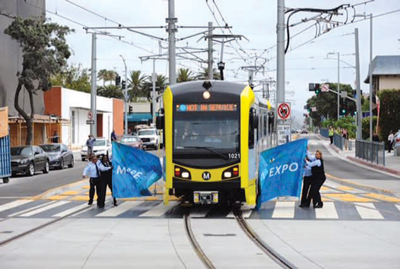|
The second phase of the Los Angeles light rail Expo Line, which runs from Culver City to Santa Monica, opened on 20 May 2016. This is the first passenger rail transit service to the far Westside of the Los Angeles Area since Pacific Electric streetcars stopped going to Santa Monica in 1953. The new rail extension also goes through the Westside Pavilion in West Los Angeles and the job-heavy tech and media corridors along Olympic Boulevard. For 34,000 Santa Monica students, the 17th Street/Santa Monica College Station is a convenient short walk or bike ride from Santa Monica College. The first phase of the Expo Line between downtown Los Angeles and Culver City opened in 2012, and heavy construction on the second phase began that same year. Train trips between downtown Santa Monica and downtown Los Angeles on the Expo Line take 46 min. “Metro is in the midst of a region-wide transit revolution,” said Los Angeles County Supervisor and Metro Board Chair Mark Ridley-Thomas. “With two rail lines opening this spring and three others under construction, as well as massive highway modernization projects underway, we are easing congestion and changing commuting patterns in all corners of the county.

The US$1.5-billion light rail project from Culver City to Santa Monica is 6.6-mi and has seven new stations: Palms, Westwood/Rancho Park, Expo/Sepulveda, Expo/Bundy, 26th Street/Bergamot, 17th Street/Santa Monica College, and Downtown Santa Monica. Each station displays decorative original art for aesthetic appeal. Three of these stations have park-and-ride facilities: Expo/Sepulveda (260 parking spaces), Expo/Bundy (250 parking spaces), and 17th Street/Santa Monica College (70 parking spaces). A new rail maintenance facility in Santa Monica that can house up to 48 light-rail vehicles is included in the Expo Line’s second phase. The Expo Line was built by the Exposition Construction Authority, an agency set up by the state to plan and build the line. Since Metro accepted the project from them, it now owns and operates the new section of Expo Line tracks.
Full article: IEEE Vehicular Technology Magazine, Volume 11, Number 3, September 2016 |